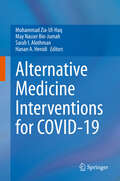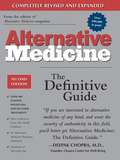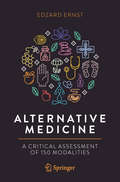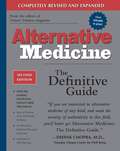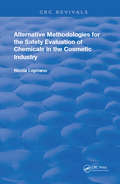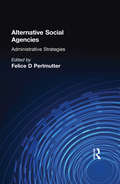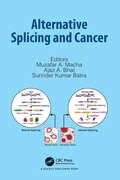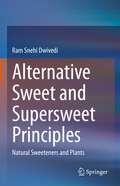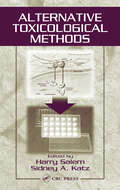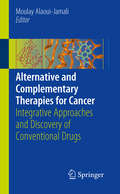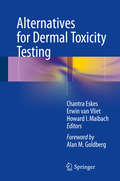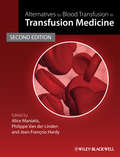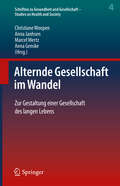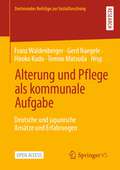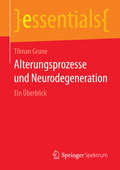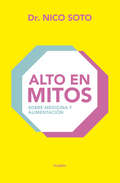- Table View
- List View
Alternative Medicine Interventions for COVID-19
by Muhammad Zia-Ul-Haq May Nasser Bin-Jumah Sarah I. Alothman Hanan A. HenidiThis research volume examines the available alternative, complementary, pharmaceutical and vaccine methods for treating, mitigating, or preventing COVID-19. Coverage includes traditional Chinese medicine, herbal remedies, nutraceutical/dietary options, and drug/vaccine therapies. All the methods discussed will be critically examined to provide readers with a full, unbiased overview that includes pros/cons of each method. While the nature of COVID-19 is still being studied, and new research and theories are being published daily, this book endeavors to provide readers with a comprehensive summary of current research on alternative and mainstream treatment and prevention methods.
Alternative Medicine, Second Edition: The Definitive Guide (Alternative Medicine Guides)
by Larry Trivieri John W. Anderson Burton GoldbergThe "Bible" of Alternative MedicineLearn the health secrets that millions of readers have discovered in the book that is revolutionizing health care in the United States. Alternative Medicine: The Definitive Guide is packed with lifesaving information and alternative treatments from 400 of the world'¬?s leading alternative physicians.Our contributors (M.D.s, Ph.D.s, Naturopaths, Doctors of Oriental Medicine, and Osteopaths) offer the safest, most affordable, and most effective remedies for over 200 serious health conditions, from cancer to obesity, heart disease to PMS. This guide is easy enough to understand to make it perfect for home reference, while it would also make a fine resource for health care providers interested in learning more about alternative medicine.70% of Americans currently use some form of alternative medicineThis 1,136-page encyclopedia puts all the schools of alternative medicine-50 different therapies-under one roofHighlights dozens of actual patient stories and physician treatments.
Alternative Medicine: A Critical Assessment of 150 Modalities
by Edzard ErnstAlternative medicine (AM) is hugely popular; about 40% of the US general population have used at least one type of alternative treatment in the past year, and in Germany this figure is around 70%. The money spent on AM is considerable: the global market is expected to reach nearly US $ 200 billion by 2025, with most of these funds coming directly out of consumers’ pockets. The reasons for this popularity are complex, but misinformation is certainly a prominent factor. The media seem to have an insatiable appetite for the subject and often report uncritically on it. Misinformation about AM on the Internet (currently about 50 million websites are focused on AM) is much more the rule than the exception. Consumers are thus being bombarded with misinformation on AM, and they are ill-protected from such misinformation and therefore prone to making wrong, unwise or dangerous therapeutic decisions, endangering their health and wasting their money. This book is a reference text aimed at guiding consumers through the maze of AM. The concept of the book is straightforward. It has two main parts. The first, short section provides essential background on AM, explaining in simple terms what is (and what is not) good, reliable evidence, and addressing other relevant issues like, for instance, the placebo response, informed consent, integrative medicine, etc. The second and main part consists of 150 short chapters, topically grouped and each dedicated to one single alternative therapeutic or diagnostic method. In each of them, seven critical points are raised. These points relate to issues that are important for consumers’ decisions whether it is worth trying the method in question. Restricting the discussion to just seven points means that issues must be prioritized to those themes which are most relevant in the context of each given modality.
Alternative Medicine: A Critical Assessment of 202 Modalities (Copernicus Books)
by Edzard ErnstAlternative medicine (AM) is popular; about 40% of the US general population have used alternative treatment in the past year, and in Germany this figure is around 70%. The global market is expected to reach nearly US $ 200 billion by 2025, with most of these funds coming directly out of consumers’ pockets. Consumers are bombarded with misleading and false information on AM and therefore prone to making wrong, unwise, or dangerous therapeutic decisions, endangering their health and wasting their money. This book is a reference text aimed at guiding consumers through the maze of AM. This second edition includes over 50 additional treatments as well as updates on many others.
Alternative Medicine: The Definitive Guide (2nd edition)
by John W. Anderson Larry Trivieri Jr.This guide is easy enough to understand to make it perfect for home reference, while it would also make a fine resource for health care providers interested in learning more about alternative medicine.
Alternative Methodologies for the Safety Evaluation of Chemicals in the Cosmetic Industry (Routledge Revivals)
by Nicola LoprienoFirst published in 1995: Alternative Methodologies for the Safety Evaluation of Chemicals in the Cosmetic Industry presents a categorization and collection of information available for the evaluation of safety using in vitro techniques. It offers a comprehensive and complete look at the entire field. In doing so, the author provides the foundation for the next phase of significant growth for this discipline.
Alternative Social Agencies: Administrative Strategies
by Felice D PerlmutterUsing a diverse set of successful alternative programs as case examples, professionals who have been involved directly in the organization and development of alternative social programs explain the complicated process of planning and implementing new agencies. Alternative social agencies have emerged over the past two decades in response to a variety of needs not being met by older established agencies, but their survival is often limited. This comprehensive volume will help all of those involved in social administration to question their own administrative practices and struggle with new approaches that can best meet the needs of their present and/or potential constituencies. Existing social agencies will find these innovative ideas to be adaptable in meeting changing social conditions, service needs, and target populations. Topics include various direct services in voluntary health-related organizations and agencies; public sector agencies that are not usually associated with alternative programs; and descriptions of effective indirect service.
Alternative Splicing and Cancer
by Ajaz A. Bhat Muzafar A. Macha Surinder Kumar BatraThis book Alternative Splicing and Cancer explores the crucial role alternative splicing, a post-transcriptional process, plays in human health and diseases, particularly cancer. Diving deep into the complexities of gene expression and protein diversity, the book illuminates how abnormal splicing contributes to aggressive tumor formation, affecting cellular functions such as proliferation, survival, and immune evasion. With a focus on understanding molecular mechanisms, this book unravels potential diagnostic and prognostic targets, opening doors for enhanced anti-cancer treatment efficacy. An indispensable resource for anyone intrigued by the interplay between gene splicing and cancer biology, it paves the way towards innovative therapeutic strategies.
Alternative Sweet and Supersweet Principles: Natural Sweeteners and Plants
by Ram Snehi DwivediThis book compiles the latest information on different kinds of natural, plant-based super sweeteners. A book on alternative, natural super sweeteners is extremely timely and useful, especially, in light of the decreasing cultivable area, ever increasing demand for sucrose, and the well identified ills of sugar consumption. Every year more than 5.0 million people die due to diabetes and diabetes-associated diseases like cardiovascular, kidney disorder, liver cancer etc. This book describes the use of non-saccharide super sweet principles to counter such maladies. The readers will get an in-depth understanding of different kinds of sweeteners, molecular basis of sweetness, their general classification, plant source with photo-plates etc. The chapters explain different kinds of super-sweet principles. This book emphasizes on the propagation, cultivation and conservation of NSSS plants (NSSSP) and extraction of super sweet principles and granting of generally recognised as safe (GRAS) certificate to sweeteners. The concluding chapter describes the eco-physiological difference between saccharide super sweet and non saccharide sweet plants. The book also describes commercial production of selected potential Natural Super Sweeteners. This book will be of great interest to researchers, extension workers as well as postgraduate students in Food science nutrition, ayurveda, plant physiology, Unani, naturopathy, biochemistry and plant breeding. It would also be of interest to industry stakeholders in sweetener industry and alternative sweetener manufactures.
Alternative Toxicological Methods
by Sidney A. Katz Harry SalemBringing together the recent and relevant contributions of over 125 scientists from industry, government, and academia in North America and Western Europe, Alternative Toxicological Methods explores the development and validation of replacement, reduction, and refinement alternatives (the 3Rs) to animal testing. Internationally recognized scientist
Alternative and Complementary Therapies for Cancer: Integrative Approaches and Discovery of Conventional Drugs
by Moulay Alaoui-JamaliCancer is a common disease with a devastating impact on the physical and psychological well being of patients. The diagnosis of cancer brings upon many clinical challenges and questions for which clear and simple answers are not always provided by modern medicine. To date, only limited therapeutic options are available for patients with advanced cancer. The recent shift toward targeted therapies has improved substantially patient's survival, however, relapses are frequent and cure remains rare. This led patients and many health care managers to shift attention to the holistic approach of traditional medicine particularly preparations from herbal products to manage and alleviate the disease. Typically, herbal preparations contain single or multiple plant ingredients, including a number of potential active components. Yet, they remain classified as food supplements and thus are exempt from regulations on quality control and proof of efficacy that govern standard pharmaceuticals. Clinical evidence for many preparations is often based on non-documented or anecdotal evidence. In consequence, several preparations with unproven efficacy are circulating in the market with the fear of interference with standard cancer therapies and/or severe toxicity that some can generate, in addition to the unjustified economical burden to patients. Despite inconsistent and conflicting clinical results single molecules have been isolated from herbal preparations and many are exploited to develop potential novel agents. This has fostered the need to organize a set of timely, in-depth and up-to-date review covering the latest developments in alternative cancer management from a scientific and clinical perspective dedicated to the medical community and health care providers, as well as to patients and their families. This book brings the latest comprehensive cancer information and practical recommendations on the best documented practice of alternative therapies for cancer management put together by recognized experts in the fields of medical oncology, traditional medicine, and cancer pharmacology. It goes hand-in-hand with the patient's medical treatment options, quality of life issues, and more. The book is organized into four major sections: The first is an overview of the cancer syndrome by renowned medical oncologists from the USA and Europe. The second is a comprehensive description of traditional medicine by renowned experts from China and Germany. The third is an overview on the pharmacological impact of herb-based formulations on standard chemotherapy agents used in clinical practice. The fourth is a survey of cases reports from several hospitals with approved practice of alternative medicine. The book will feature simple definitions and essential information grouped in both medical and lay-term terminology, and straightforward illustrations related to human physiology, disease definition, scientific data on know and potential mechanisms of action, and preventive approaches. Finally, the book will feature collaboration of experts from China, India, USA, Canada, Germany, France, and other centres with recognized expertise in alternative/traditional medicine. This international cooperation is crucial to cover the complex topic of alternative therapies for cancer.
Alternative operative Therapien in der Uroonkologie: Operationen, Interventionelle Techniken, Radiochemotherapie
by Martin Schostak Andreas BlanaNeue Wege in der operativen Uroonkologie! Dieses Buch beschreibt besondere operative Verfahren in ihren Einsatzfeldern von der praktischen Durchf#65533;hrung bis zu ihrer Stellung in der Literatur und den Leitlinien. Dar#65533;ber hinaus geben die ausgewiesenen Experten Hinweise, wie solche Operationen praktisch, m#65533;glichst risikoarm und effektiv zu gestalten seien. Im Spannungsfeld zwischen den Radikaltherapien auf der einen Seite und dem vor#65533;bergehenden Nichtbehandeln auf der anderen Seite suchen viele Betroffene nach sogenannten alternativen Therapien. Dabei handelt es sich um Verfahren, welche als noch nicht standardisiert gelten. Ziel soll eine m#65533;glichst gleichwertige Krebstherapie bei weniger Invasivit#65533;t bzw. besserem Erhalt der Lebensqualit#65533;t sein. Unter anderem finden sich folgende Themen im Buch: #65533; Hochintensiver fokussierter Ultraschall (HIFU) #65533; Kryotherapie #65533; Tookad #65533; Brachytherapie #65533; Alternative Therapien bei Nierenzellkarzinom, Urothelkarzinom und Hodenkarzinom
Alternatives for Dermal Toxicity Testing
by Howard I. Maibach Chantra Eskes Erwin Van VlietThis book provides comprehensive information on the alternative (non-animal) dermal toxicity test methods currently available for industrial, regulatory, and academic use and also explores potential future developments. It encompasses all areas of dermal toxicity, including skin irritation, skin corrosion, skin sensitization, UV-induced effects, and skin genotoxicity. An individual chapter is devoted to each test method, with coverage of the scientific basis, validation status and regulatory acceptance, applications and limitations, available protocols, and potential role within testing strategies. In addition, perspectives from the test developer are presented, for example regarding critical steps in the protocol. The closing section addresses areas that may be of relevance for the future of dermal toxicity safety testing, including the validation and regulatory acceptance of integrated testing strategies, novel complex skin models, and high-throughput screening techniques.
Alternatives in Cancer Therapy
by Ross Pelton Lee OverholserTHE COMPLETE GUIDE TO NON-TRADITIONAL TREATMENTS
Alternatives to Animal Testing: Proceedings of Asian Congress 2016
by Hajime Kojima Troy Seidle Horst SpielmannThis open access book presents recent advances in the pure sciences that are of significance in the quest for alternatives to the use of animals in research and describes a variety of practical applications of the three key guiding principles for the more ethical use of animals in experiments – replacement, reduction, and refinement, collectively known as the 3Rs. Important examples from across the world of implementation of the 3Rs in the testing of cosmetics, chemicals, pesticides, and biologics, including vaccines, are described, with additional information on relevant regulations. The coverage also encompasses emerging approaches to alternative tests and the 3Rs. The book is based on the most informative contributions delivered at the Asian Congress 2016 on Alternatives and Animal Use in the Life Sciences. It will be of value for those working in R&D, for graduate students, and for educators in various fields, including the pharmaceutical and cosmetic sciences, pharmacology, toxicology, and animal welfare. The free, open access distribution of Alternatives to Animal Testing is enabled by the Creative Commons Attribution license in International version 4: CC BY 4.0.
Alternatives to Antibiotics against Pathogens in Poultry
by Awad A. Shehata Guillermo Tellez-Isaias Wolfgang EisenreichThis volume provides a comprehensive overview of poultry intestinal health and recent advances in alternatives to drug treatment of significant disorders. The chapters start with an insight into immunological processes and the communities of gut microbiota. In the following, a range of antibiotic alternatives in poultry feed and production management is presented, including enzymes, phytobiotics, bacteriophages, the use of probiotics, synbiotics, and many more. Expert contributions on the latest technological and diagnostic developments in the field round off this work to accelerate the study of natural products and next-generation disease therapy. Meeting the demand to combat increased resistance to classic treatment methods, this book forms an indispensable guide for all professionals, veterinarians, nutritionists, students and researchers in the poultry industry, food production, and academia.
Alternatives to Antibiotics: Recent Trends and Future Prospects
by Tilak Saha Manab Deb Adhikari Bipransh Kumar TiwaryThis book discusses prospective alternative approaches to fight bacterial infections to minimize the indiscriminate use of conventional antibiotics. It offers the current knowledge on research and development of alternative antibacterial agents such as probiotics, nanobiotics etc. while it also discusses newly emerging trends such as phage therapy, antibody therapy etc. The book highlights on the phytochemicals with potent antibacterial activities as alternatives to conventional antibiotics. Chemical modification to develop next generation antibiotics with enhanced efficacy has also been included. Such modifications are reported to overcome the inherent resistance of the parent antibiotics. Phage therapy and targeted antibodies are considered as potential alternative approaches to treat bacterial ailments and represent areas of cutting-edge research and have therefore been discussed with sufficient care. Mainly, the book highlights various approaches other than conventional antibiotics in treating bacterial infections. The scientific advancements in these areas will strengthen the ‘One Health’ approach benefiting human beings, animals and environment as well. This book is a comprehensive resource to cater researchers, biological scientists, herbalists and clinical practitioners with up-to-date information on antibacterials other than antibiotics.
Alternatives to Blood Transfusion in Transfusion Medicine
by Jean-François Hardy Phillipe van der Linden Alice ManiatisMeeting the needs of patients while minimizing blood transfusions requires special expertise, precise monitoring and innovative techniques. This cutting-edge resource covers all the important clinical aspects of transfusion medicine in diverse clinical settings, with a special emphasis on alternatives to transfusion.Edited by a multidisciplinary team consisting of a transfusion specialist, an anesthesiologist and an intensive care specialist this book is endorsed by the Network for Advancement of Transfusion Alternatives. The contributors review the appropriate use of fluids and of blood products, and describe the latest treatment options available to decrease the need for allogeneic blood products including:Argon beamCell saverHarmonic scalpelNormovolemic haemodilutionSynthetic erythropoietinAntifibrinolyticsRecombinant factor VIIaAdvanced monitoring of hemostasisIntravenous ironThe new edition is a key reference source for all those involved in the practice of blood management and conservation.
Alternde Gesellschaft im Wandel: Zur Gestaltung einer Gesellschaft des langen Lebens (Schriften zu Gesundheit und Gesellschaft - Studies on Health and Society #4)
by Marcel Mertz Christiane Woopen Anna Janhsen Anna GenskeDas Buch untersucht die inhaltlichen und strukturellen Herausforderungen, vor der unsere Gesellschaft angesichts einer stetig steigenden Lebenserwartung und einer zunehmenden Vielfalt unterschiedlicher Lebensentwürfe steht. Sind wir vorbereitet auf die Bedürfnisse einer alternden Bevölkerung? Wie sollen wir auf den demografischen Wandel reagieren, um ein würdevolles Altern sicherzustellen? Wie müssen wir die unterschiedlichen Lebensbereiche wie Arbeitswelt, Gesundheitsversorgung, Wohnen und Kultur gestalten und anpassen, um den veränderten Lebensläufen gerecht zu werden? Entlang der Dimensionen Alterung, Diversität und Technisierung widmen sich in diesem Band Experten aus Medizin, Ethik, Recht, Sozialwissenschaften, Pädagogik, Kunstgeschichte und Gerontologie Möglichkeiten und Bedingungen des ‚guten Alterns‘ in einer Gesellschaft des langen Lebens.
Altersdepression: Ein interdisziplinäres Handbuch
by Martin Hautzinger Andreas FellgiebelIn diesem sehr praxisnahen Handbuch zur Altersdepression werden s#65533;mtliche allgemeinen wie auch sehr spezielle Therapieoptionen #65533;bersichtlich und pr#65533;zise dargestellt. Es wurde h#65533;chster Wert auf die Alltagstauglichkeit der Inhalte gelegt, damit Arzt und / oder Therapeut die hier beschriebenen Therapieverfahren schnell anwenden kann. Im ersten Teil des Buchs werden die f#65533;r das Verst#65533;ndnis der Altersdepression wichtigen Besonderheiten abgehandelt, der zweite Teil umfasst die Therapiem#65533;glichkeiten unter Ber#65533;cksichtigung der biologischen und psychologischen Bedingungen des Alters, der dritte Teil stellt etablierte und neue Behandlungsrahmen sowie innovative Therapiekonzepte vor.
Altersgemischte Teams in der Pflege: Miteinander arbeiten - voneinander lernen
by Jessica SchäferVielfalt statt Einfalt!Dieses Buch richtet sich an Führungspersonen und Praktiker im Pflegebereich und zeigt alle wichtigen Aspekte für ein erfolgreiches Arbeiten im Team mit unterschiedlichen Generationen. Der Mix aus verschiedenen Altersgruppen in einem Team ist nur in den seltensten Fällen ein erfolgreicher Selbstläufer. Vielmehr kommt es darauf an, die Mischung gut zusammenzustellen und immer wieder aufs Neue entsprechend zu dosieren. Die einzelnen Zutaten dazu und wie es gelingen kann, finden Sie in diesem Buch. Verständlich, humorvoll und „auf dem Punkt“ beschreibt die erfahrene Autorin, wie die Zusammenarbeit der verschiedenen Generationen für alle Beteiligten erfolgreich sein kann.
Alterspsychotherapie und klinische Gerontopsychologie
by Andreas MaerckerDer Anteil älterer Patienten in psychotherapeutischen Praxen nimmt zu. Können Sie mit diesen Patienten umgehen? Eine adäquate Diagnostik und Behandlung ist ohne ein grundlegendes Verständnis für den älteren Menschen nicht möglich. In drei klar strukturierten Teilen bietet dieser Therapieleitfaden - die Grundlagen der Gerontopsychologie und -psychotherapie, - Störungen, die im Mittelpunkt des therapeutischen Einzelsettings stehen, - hochrelevante Problemfelder, in denen Sie als Therapeut über das übliche Therapiesetting hinaus wirksam werden können. Das ansprechende und übersichtliche Layout, Hervorhebungen von Kernaussagen, zahlreiche Übersichten, Übungsbeispiele und Therapiematerialien machen das Buch zu einem unentbehrlichen Leitfaden für Weiterbildung und Praxis.
Alterung und Pflege als kommunale Aufgabe: Deutsche und japanische Ansätze und Erfahrungen (Dortmunder Beiträge zur Sozialforschung)
by Franz Waldenberger Tomoo Matsuda Gerd Naegele Hiroko KudoDie Beiträge in diesem Open-Access-Sammelband beschreiben und analysieren aus multidisziplinärer Sicht die Herausforderungen und Bewältigungsstrategien von Alterung und Pflege in japanischen und deutschen Gemeinden. Thematisiert werden rechtliche Rahmenbedingungen, zivilgesellschaftliches Engagement, Pflegekräftemangel, Technologiekonzepte für die Pflege und schließlich auch der Einfluss der Covid-19 Pandemie auf die Situation älterer und pflegebedürftiger Bürgerinnen und Bürger. Die Gegenüberstellung der Ansätze und Erfahrungen beider Länder erweitert das Spektrum an Gestaltungsmöglichkeiten und kann Impulse für eine Neuausrichtung bestehender Lösungsstrategien geben.
Alterungsprozesse und Neurodegeneration: Ein Überblick (essentials)
by Tilman GruneDas Essential behandelt in leicht verständlicher, komprimierter Weise dieGrundlagen altersbedingter Zellveränderungen, die unter Umständen zurNeurodegeneration führen können. Der Autor erläutert, wie der Alterungsprozess und die Neurodegeneration durch oxidativen Stress und dabei entstehende Schäden beeinflusst werden. Unter diesen Schäden nimmt die Bildung von Proteinaggregaten, die hier besonders ausführlich beschrieben werden, eine Schlüsselstellung ein. Darüber hinaus werden einige Aspekte der Ernährung im Alter und ihre möglichen Auswirkungen auf die Entstehung von neurodegenerativen Erkrankungen vorgestellt.
Alto en mitos: Sobre medicina y alimentación
by Dr. Nico SotoEn este libro, el doctor Nico Soto derribará todos los mitos que nos han impedido tener una vida más saludable. A todos nos han dicho cosas que supuestamente nos ayudarán a tener una vida más saludable. ¿Comer cada tres horas? ¿Dejar los carbohidratos? ¿Evitar la fruta porque tiene mucha azúcar? Estas son algunas de las cosas que creemos completamente ciertas y se han posicionado en nuestra sociedad como verdades inamovibles… pero ¡son mitos! El doctor Nicolás Soto nos hace un recorrido por todas estas creencias que por años nos han hecho comer cosas poco saludables, y así derribar los mitos de una vez por todas. Con ingenio y de forma lúdica, nos ayuda a tomar las riendas de nuestra salud y nunca más caer en las mentiras que se han masificado gracias a la influencia de industrias y corporaciones.
